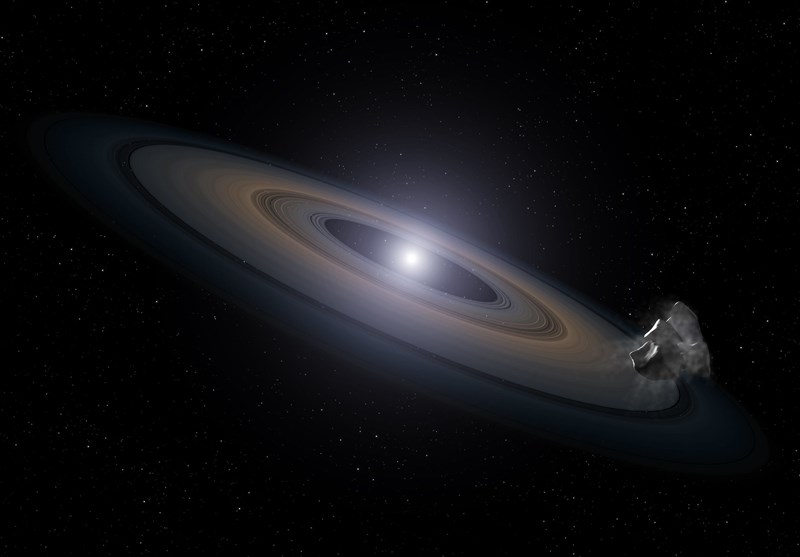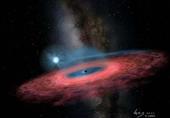Hidden Giant Planet Revealed Around Tiny White Dwarf Star
TEHRAN (Tasnim) - The first evidence of a giant planet orbiting a dead white dwarf star has been found in the form of a disc of gas formed from its evaporating atmosphere.
A white dwarf is the burnt-out core of a star similar to the sun that has eventually ran out of fuel, swelled up into a red giant, only to lose about half of its mass in the subsequent phase of its life, before shrinking to a dead remnant of its former glory.
The first indirect evidence of a giant planet orbiting a dead white dwarf star has been found by team of astronomers from the University of Warwick’s Department of Physics and the Millennium Nucleus for Planet Formation (NPF) at the University of Valparaiso, Sputnik reported.
According to results of their study, published in the journal Nature, the evidence is in the form of a comet-like tail of gas formed by the evaporating atmosphere of the planet, thought to be over four times the size of the Earth-sized white dwarf.
The Neptune-like planet orbits the star about once every ten days, leaving in its wake a plume of gas comprised of hydrogen, oxygen, and sulfur.
Until now, there has never been evidence of a planet that has survived a star’s transition to a white dwarf.
Glimpse into “future of our solar system”
The star WDJ0914+1914 was identified in a survey of ten thousand white dwarfs observed by the Sloan Digital Sky Survey.
Using the Very Large Telescope of the European Southern Observatory in Chile to zoom in on the star, scientists found that the shape of its hydrogen, oxygen, and sulfur features were typical indicators of a ring of gas.
Lead author Dr. Boris Gaensicke, from the University of Warwick, was quoted by SciTechDaily as saying:
“Such a system has never been seen before, and it was immediately clear to me that this was a unique star.”
Analysing the data, the team of scientists measured the composition of the disc, concluding that it matches what scientists anticipate for the deeper layers of our own solar system’s ice giants, Uranus and Neptune.
A member of the research team, Dr. Matthias Schreiber from the University of Valparaíso, demonstrated through a set of calculations that the 28,000 degrees Celsius hot white dwarf is slowly evaporating this hidden icy giant, bombarding it with high energy photons and pulling its lost mass into a gas disc around the star.
According to Dr. Schreiber, WDJ0914+1914 offers a glimpse into the very distant “future of our own solar system.”
Dr. Gaensicke claimed the discovery marked major progress, elaborating:
“Over the past two decades we had growing evidence that planetary systems survive into the white dwarf stage. We’ve seen a lot of asteroids, comets and other small planetary objects hitting white dwarfs. Having evidence for an actual planet that itself was scattered in is an important step.”
The discovery is potentially groundbreaking as it suggests that there could be many more planets around such stars waiting to be discovered, possibly detectable using the transit method once the Large Synoptic Survey Telescope in Chile becomes operational by 2020.
The white dwarf observed in the study in its heyday used to be a star similar to the sun but eventually ran out of fuel.
After swelling up into a red giant, a few 100 times the size of the sun, it subsequently lost about half of its mass, with the remainder shrinking dramatically. Ending up the size of the Earth, the white dwarf is essentially the burnt-out core of the former star.
Once our own sun runs out of fuel in about 4.5 billion years it will shed its outer layers, destroying Mercury, Venus, and probably the Earth, eventually exposing its burnt-out core — the white dwarf.
In a companion paper led by Dr. Schreiber and Dr. Gaensicke and published in Astrophysical Journal Letters, the scientists offer an account of how this will radiate enough high energy photons to evaporate Jupiter, Saturn, Uranus, and Neptune.
Just as on WDJ0914+1914, some of that atmospheric gas will end up on the white dwarf left behind by the sun, and will be observable for future generations of alien astronomers, assuming they will be around to do so.






